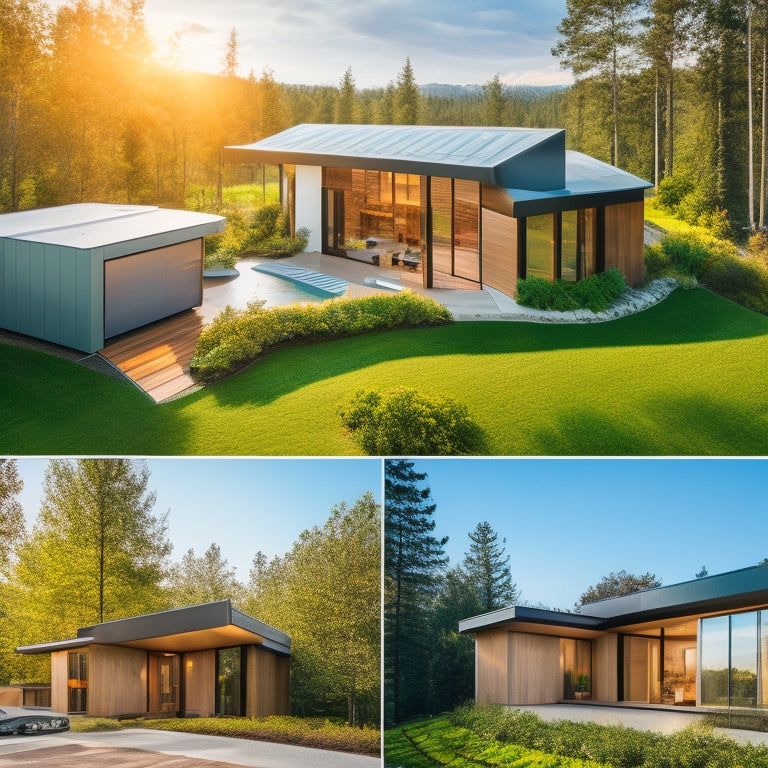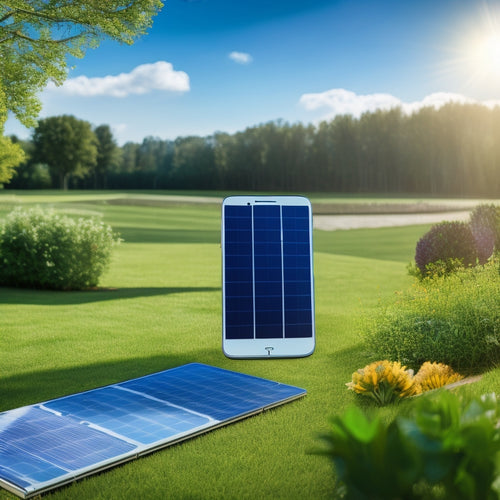
Energy-Efficient Insulation Solutions for Net-Zero Homes
Share
By incorporating energy-efficient insulation solutions into your net-zero home, you can reduce energy consumption by up to 30% and greatly lower your carbon footprint. You'll have a range of materials to choose from, including spray foam, cellulose fiber, fiberglass batt, and rigid foam board, each with its own benefits and drawbacks. Consider specialized solutions like radiant barriers, structural insulated panels, and insulated metal panels for specific applications. As you investigate the world of energy-efficient insulation, you'll uncover how to optimize your home's performance, minimize energy bills, and contribute to a sustainable future - and that's just the beginning of your expedition towards a net-zero dream home.
Key Takeaways
- Energy-efficient insulation significantly reduces energy consumption and costs, contributing to sustainability and lower energy bills in net-zero homes.
- Spray foam, cellulose fiber, fiberglass batt, rigid foam board, and natural fiber insulations are common materials used for energy-efficient insulation.
- Insulation performance metrics, including R-value, thermal conductivity, moisture absorption, air permeability, and embodied energy, help evaluate insulation effectiveness.
- Effective insulation strategies for walls, windows, roofs, and foundations involve selecting the right materials and designing for thermal resistance, air tightness, and moisture management.
- Proper insulation can lead to up to 30% energy savings, improved HVAC efficiency, and a consistent indoor climate in net-zero homes.
Insulation Types for Net-Zero Homes
When building a net-zero home, selecting the right insulation type is essential, as it directly impacts the structure's energy efficiency and carbon footprint.
You'll want to evaluate insulation materials that not only reduce heat transfer but also minimize environmental impact. In addition, incorporating solar-powered charging solutions can further reduce reliance on traditional power sources and lower carbon emissions.
Spray foam insulation, for instance, offers high R-values and can be made from recycled materials. However, its high embodied energy and potential VOC emissions may be drawbacks.
Cellulose fiber insulation, on the other hand, is a more eco-friendly option, composed of recycled paper products and natural fibers. It's a great choice for those prioritizing sustainability, but it may not perform as well in extreme temperatures.
Benefits of Energy-Efficient Insulation
By incorporating energy-efficient insulation into your home, you'll greatly reduce your energy consumption, which in turn will lower your energy bills.
This is because energy-efficient insulation helps to minimize heat loss in the winter and heat gain in the summer, allowing your heating and cooling systems to work more efficiently.
Additionally, using renewable energy sources like solar power to generate electricity can further reduce your reliance on fossil fuels and promote sustainability.
As a result, you'll not only save money on your energy bills, but you'll also reduce your carbon footprint and contribute to a more sustainable future.
Reduced Energy Consumption
You can considerably cut down on your energy bills by installing energy-efficient insulation in your home or building. By reducing heat loss and gain, you'll minimize the load on your HVAC system, which translates to lower energy consumption.
This, in turn, reduces your carbon footprint and contributes to a more sustainable future. Additionally, adopting renewable energy solutions, such as solar energy implementation, can further decrease your reliance on fossil fuels.
Some key benefits of energy-efficient insulation include:
- Minimizing thermal bridging, which occurs when heat escapes through gaps and cracks in the building envelope
- Optimizing your building's energy performance, as revealed by thorough energy audits
- Reducing the strain on your HVAC system, leading to extended equipment lifespan and lower maintenance costs
- Creating a more consistent and comfortable indoor climate, free from drafts and hotspots
- Supporting your goal of achieving net-zero energy status, where your building produces as much energy as it consumes
Lower Energy Bills
Lower energy bills are a direct result of energy-efficient insulation, and it's a benefit that strikes a chord deeply with homeowners and businesses alike.
You'll notice the difference in your wallet, as energy savings add up over time. In fact, a well-insulated home can save you up to 30% on your energy bills.
Shifting to renewable energy sources like solar and wind power can further reduce your carbon footprint. That's a significant reduction in cost, and it's an essential step towards achieving a net-zero home.
By investing in energy-efficient insulation, you're not only reducing your energy consumption, but also increasing your cost effectiveness.
With lower energy bills, you'll have more freedom to allocate your resources where they matter most.
Insulation Materials for Sustainability
Sustainable buildings rely on insulation materials that not only reduce energy consumption but also minimize environmental impact. As you choose insulation materials for your net-zero home, you'll want to prioritize eco-friendly options that align with your values.
Consider the following sustainable insulation materials:
-
Recyclable materials: Look for materials that can be reused or recycled at the end of their life cycle, reducing waste and conserving natural resources. For instance, solar panels, which can have manufacturer warranties extending up to 25 years solar incentives, can also be recycled, making them a significant resource in the fight against climate change.
-
Natural fibers: Options like wool, cotton, and hemp offer a renewable and biodegradable alternative to synthetic materials.
-
Eco-friendly spray foams: Some spray foams are made from natural oils and recycled materials, providing a high-performance insulation solution with a lower environmental footprint. Regular maintenance, such as cleaning solar panels every 6-12 months proper installation methods, can also guarantee ideal energy harvesting.
-
High-performance fiberglass: This option boasts high R-values while being made from recycled glass and requiring less energy to produce.
-
Rigid foam boards: Made from recyclable materials, these boards offer exceptional thermal performance and can be reused in future construction projects.
Walls and Windows Insulation Options
You're now considering the most critical components of your building's envelope: walls and windows.
When it comes to wall insulation options, you'll want to investigate choices like fiberglass batts, spray foam, and rigid foam board to determine which best suits your climate and budget.
Meanwhile, window insulation choices, such as low-e coatings, double- or triple-glazed panes, and thermal breaks, will also play a significant role in minimizing heat transfer and energy loss.
Wall Insulation Options
Across the exterior envelope of your home, walls and windows are particularly vulnerable to heat transfer, making them prime targets for energy-efficient insulation solutions.
As you design your net-zero home, it's crucial to select wall insulation options that not only reduce heat loss but also provide soundproofing solutions and minimize thermal bridging.
Consider the following wall insulation options:
- Fiberglass batt insulation, a cost-effective solution with high R-values
- Spray foam insulation, which provides a high level of air tightness and can be used in tight spaces
- Rigid foam board insulation, ideal for exterior applications and providing a high level of thermal resistance
- Reflective insulation, which can be used in conjunction with other insulation materials to maximize energy efficiency
- Structural insulated panels (SIPs), which provide a high level of insulation and can be used for entire walls or as a component of a hybrid system
Window Insulation Choices
Optimize your window insulation with high-performance solutions that minimize heat transfer and maximize energy efficiency.
As you design your net-zero home, consider thermal curtains that reduce heat loss by up to 25%. These curtains feature advanced materials with high R-values, keeping warmth in during winter and out during summer.
For an added layer of protection, apply window films that reflect heat and reduce solar gain. These films can be installed on existing windows, making them a cost-effective solution.
Roof Insulation for Maximum Efficiency
When it comes to achieving maximum energy efficiency in a building, one essential aspect often overlooked is the roof.
As you design your net-zero home, don't neglect the importance of proper roof insulation. You'll want to make certain that your roof is equipped with the right materials to minimize heat transfer and maximize thermal resistance.
Some effective roof insulation solutions include:
- Radiant barriers to reflect heat rather than absorb it
- Fiberglass batts with high R-values for peak thermal performance
- Spray foam insulation for airtight sealing and superior R-values
- Rigid foam board insulation for exterior continuous insulation
- Insulated metal panels for a durable, energy-efficient roofing solution
Insulation for Foundations and Basements
As you seal your roof from heat transfer, don't forget that heat can also seep in from below. Insulating your foundation and basement is essential to prevent heat loss and moisture intrusion.
You'll want to focus on reducing foundation moisture, which can lead to mold growth and structural damage. Proper basement ventilation is also key to removing excess moisture and reducing the risk of mold.
Consider using foam board insulation or spray foam insulation around the foundation perimeter and under the basement slab. Don't forget to insulate any exposed pipes and ducts in the basement to further reduce heat loss.
Measuring Insulation Performance Metrics
Measuring insulation performance metrics is an essential step in ensuring your home operates at peak energy efficiency. You need to know how well your insulation is performing to make informed decisions about upgrades or repairs.
Insulation testing helps you determine the thermal resistance of your insulation, which is important for maintaining a comfortable and energy-efficient living space.
When evaluating insulation performance, consider the following key metrics:
- Thermal resistance (R-value): measures the ability of insulation to resist heat flow
- Thermal conductivity: measures the rate of heat transfer through the insulation material
- Moisture absorption: measures the insulation's ability to resist water damage
- Air permeability: measures the insulation's ability to prevent air leakage
- Embodied energy: measures the energy required to produce and install the insulation
Frequently Asked Questions
Can I Install Insulation Myself or Do I Need a Professional?
You can attempt DIY insulation, but consider the intricacies and potential risks; if you're not experienced, it's advised to hire a professional for a precise installation that guarantees peak performance and energy efficiency.
How Long Does Insulation Typically Last Before Needing Replacement?
You'll typically get 20-30 years of performance from your insulation, but factors like moisture, compression, and settling can shorten its lifespan. Keep an eye out for signs like reduced R-value, mold growth, or increased energy bills, which indicate it's time for replacement.
Are There Any Government Incentives for Energy-Efficient Insulation?
You'll be surprised to know that 25% of energy consumption in the US is attributed to heating and cooling! As you consider energy-efficient insulation, you can benefit from government incentives like tax credits and rebate programs, which can help offset the costs of eco-friendly upgrades.
Can Insulation Be Used in Historic or Vintage Homes?
When restoring a historic or vintage home, you'll need to balance preservation with energy efficiency, considering vintage insulation techniques and historic preservation considerations to guarantee the integrity of the original structure while achieving your eco-friendly goals.
Are Energy-Efficient Insulation Materials More Expensive Than Traditional Ones?
You might assume energy-efficient insulation materials break the bank, but surprisingly, they're often on par with traditional options; a cost comparison reveals some eco-friendly materials, like recycled denim, are even more affordable, offering a guilt-free upgrade to your dream home.
Related Posts
-

3 Earth-Loving Furniture Tips for Energy-Smart Homes
When furnishing your energy-smart home, you have the power to reduce your carbon footprint greatly by making consciou...
-

7 Best Solar Panel Upkeep Apps for Homeowners
You can optimize your solar panel's energy output and efficiency by up to 20% with regular maintenance, which is wher...
-

10 Powerful Electric Mowers for Expansive Lawns
You're moving away from gas-powered mowers and exploring electric options for your expansive lawn. You'll find that h...


